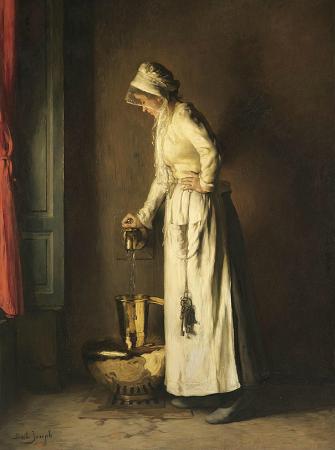Joseph Bail (1862 - 1921). Joseph Bail, born onJanuary 22, 1862 in Limonest and died on November 28, 1921 in Neuilly-sur-Seine, was a naturalistic French painter. Younger brother of the painter Franck Bail, Joseph Bail received his first training from his father, Antoine Jean Bail, practitioner of the realistic tradition of genre subjects, before going through the studio of Jean-Léon Gérôme and that of Carolus-Duran. As a teenager, he produced his first still lifes in 1878. A year later, he presented works at the Salon of the Society of French Artists. A few years later, he became one of the youngest medalists of honor for his painting Trinkets from the Cluny museum at the Salon of 1886, then for his famous Le Marmiton. Passionate about the world of gastronomy, he paints food just as much as those who helped prepare it. He declines the cooks in different ways in the cigarette or Rest and in The Besogne made where the young clerk, slumped in a chair, casually smoking a cigarette. He continued in the same vein with Les Cuisiniers, Reflets de soleil and Bataille de chien. He received the gold medal at the 1900 Universal Exhibition for three major works: Le Goûter, Bulles de Soap and La Servante [Performing works in the Dutch or Flemish taste, he endeavors to reproduce interior scenes. He is particularly skilled in rendering the shine of copper, in playing with the light of a ray of sunlight which enters the room furtively, offering Gérald Schurr to perceive in him a distant emulator of Caravaggio, practicing Scholarly backlights à la Zurbarán. He later distinguished himself with compositions featuring maids. Following a visit to the hospices de Beaunecarried out in 1902, he gradually took an interest in the life of the hospital nuns. From this visit will be born Le Bénédicité, Un coin de lingerie and La Cuisine. Working in his Parisian workshops in rue Legendre and in Bois-le-Roi, rue de la Mairie, he presented one of his last works in 1921, La Citronnade, and died a few weeks later in Neuilly-sur-Seine, November 28, 1921. His characteristic work reflects less the influence of his academic masters than the study of Chardin's paintings which he had seen in the Louvre, and the works of realistic contemporaries such as Antoine Vollon and Théodule Ribot. An intimate painter, he brings care and reflection to the arrangement of the elements of the decor and he shows a lot of refinement and accuracy in the choice of colors.
more...













